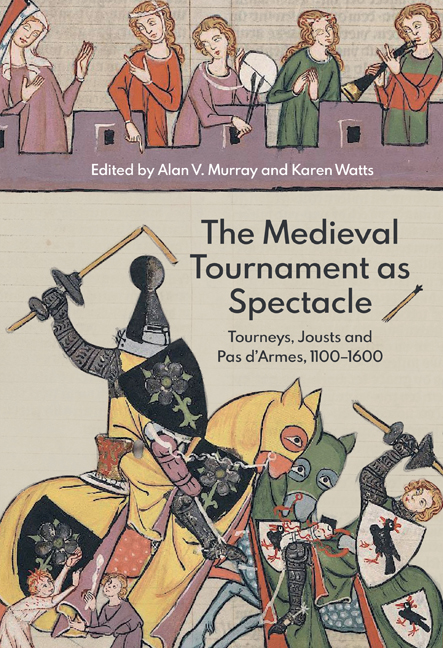Book contents
- Frontmatter
- Contents
- List of Illustrations
- List of Contributors
- Preface and Acknowledgements
- Introduction: From Mass Combat to Field of Cloth of Gold
- Research on the Medieval Tournament (1100–1600): A Select Bibliography
- 1 Now Form Up Close Together! Tactics and Ethos of the Tourney in Early German Sources (Twelfth to Thirteenth Centuries)
- 2 Por pris et por enor: Ideas of Honour as Reflected in the Medieval Tournament
- 3 Richard II of England and the Smithfield Tournament of October 1390: An Instrument to Establish Royal Authority
- 4 Alle myn harneys for the justes: Documents as a Source for Medieval Jousting Armour
- 5 The Tournament Saddle
- 6 Between Sport and Theatre: How Spectacular was the Pas d’armes?
- 7 Art Imitating Life Imitating Art? Representations of the Pas d’armes in Burgundian Prose Romance: The Case of Jehan d’Avennes
- 8 The Foot Combat as Tournament Event: Equipment, Space and Forms
- 9 Power and Pageantry: The Tournament at the Court of Maximilian I
- 10 The Field of Cloth of Gold: Arms, Armour and the Sporting Prowess of King Henry VIII and King Francis I
- Appendix 1 Calendar of the Royal Combats at the Field of Cloth of Gold, June 1520
- Appendix 2 Articles for the Challenge: The Emprise
- Index of Objects
- Index of Manuscripts
- General Index
4 - Alle myn harneys for the justes: Documents as a Source for Medieval Jousting Armour
Published online by Cambridge University Press: 11 September 2020
- Frontmatter
- Contents
- List of Illustrations
- List of Contributors
- Preface and Acknowledgements
- Introduction: From Mass Combat to Field of Cloth of Gold
- Research on the Medieval Tournament (1100–1600): A Select Bibliography
- 1 Now Form Up Close Together! Tactics and Ethos of the Tourney in Early German Sources (Twelfth to Thirteenth Centuries)
- 2 Por pris et por enor: Ideas of Honour as Reflected in the Medieval Tournament
- 3 Richard II of England and the Smithfield Tournament of October 1390: An Instrument to Establish Royal Authority
- 4 Alle myn harneys for the justes: Documents as a Source for Medieval Jousting Armour
- 5 The Tournament Saddle
- 6 Between Sport and Theatre: How Spectacular was the Pas d’armes?
- 7 Art Imitating Life Imitating Art? Representations of the Pas d’armes in Burgundian Prose Romance: The Case of Jehan d’Avennes
- 8 The Foot Combat as Tournament Event: Equipment, Space and Forms
- 9 Power and Pageantry: The Tournament at the Court of Maximilian I
- 10 The Field of Cloth of Gold: Arms, Armour and the Sporting Prowess of King Henry VIII and King Francis I
- Appendix 1 Calendar of the Royal Combats at the Field of Cloth of Gold, June 1520
- Appendix 2 Articles for the Challenge: The Emprise
- Index of Objects
- Index of Manuscripts
- General Index
Summary
William, Baron Bergavenny, was so familiar with his jousting equipment that he could, in his will of 1408, simply refer to it as his h[ar]neys. In the same way John, Earl Warenne, left tout mon hernoys p[u]r le Jouster (all my harness for jousting) to his son in 1347. For Bartholomew, Lord Burghersh, in 1369 these were les armes entier p[u]r les joustez q[ue] fuist pur mon corps (all the jousting arms that were for my body). A Leicestershire knight's possessions were laconically recorded as Justy[n]gherneys in 1374. The term harness, of obscure origin, became synonymous with the armour borne by warriors. As a horse is strapped and buckled into its harness, so too is the man into his. Bearing such contemporary familiarity in mind, is it possible to unpick some detail and provide a deeper insight into the specialised equipment used by jousters? In this essay I seek to prove that this can be done – to some extent – and that through an examination of such documents as wills, inventories and household payments a picture will emerge of both the dynamic evolution and stagnant decay of this jousting ‘harness’. These sources are all the more important to the study of the origins and development of the joust as very little material culture has passed down to us. They also provide solid dating evidence, unlike many other textual sources such as romances and poems.
Firstly, a frank admission. Akin to the amusing theatrical prelude to the Pas d’armes of the Perron Phae, I consider myself merely to be the nain standing on the shoulders of the geans who have gone before. I have mined a rich seam of references and chased down numerous footnotes from the glossarists Du Cange and Gay, and such scholars of arms and armour as Meyrick, Baron de Cosson, Viscount Dillon, Way, Laking, Beard, ffoulkes, Mann, Norman, Anglo, and Blair. I have endeavoured – wherever possible – to make my own transcriptions of original documents and have thus, as that sage knight Philippe de Mézieres advises, imbibed directly from the fount rather than from its streams.
- Type
- Chapter
- Information
- The Medieval Tournament as SpectacleTourneys, Jousts and Pas d'Armes, 1100-1600, pp. 77 - 98Publisher: Boydell & BrewerPrint publication year: 2020

